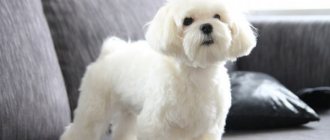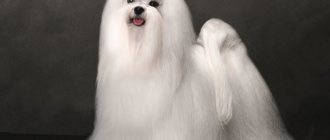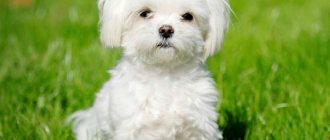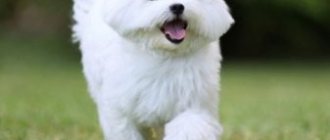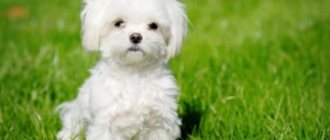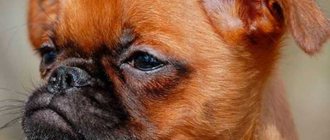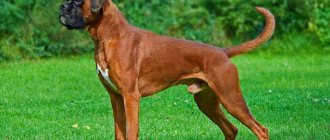These are not just decorative miniature dogs created for soft beds and spa treatments. Dogs actually served on ships, in palace storerooms, and on farms. Brave Bolonkas caught rodents, protected their owners from robbers, and saved them from cold and melancholy. Now breeds from this group constantly appear at exhibitions, in show programs, and participate in circus and theater performances. Animals love attention and human care.
Bichon Frize
The breed appeared a long time ago, in the 13-14th century on the Canary Islands. The animals were not specially bred. The sailors found small white curly dogs in the tropical forests and decided to bring them to the mainland. During the voyage, the Bichons showed hunting qualities: they boldly hunted rats and mice in the holds, and protected provisions. Therefore, the sailors kept some of the individuals for themselves, and sold others to Europeans.
Canary Bichons found their way to Spain, Italy, England and France. Each country improved dogs in its own way. The Bichon Frize is a French breed that is loved not only by aristocrats, but also by street performers. Dogs can be found on circus posters or paintings from the 15th to 18th centuries.
Curly light coat is a natural necessity. This cover repels the sun's rays and does not accumulate heat. This was the inspiration for the name of the breed: frize from French - curly.
Despite the fact that dogs are considered decorative, they are much denser, larger and heavier than “sofa” pets. Bichons are larger than Chihuahuas or Toy terriers and can grow up to 30 cm and weigh more than 5 kg. In addition, springy curly hair (up to 10 cm, corkscrew curls) adds volume. The only acceptable color is white; red spots are typical only for puppies.
Active, positive, cheerful dog. An ideal family pet that values and loves all members of the household equally. Bichons are kind, flexible, and get along with children. They like games and sports.
Thanks to their mental abilities and physical fitness, Lapdogs can cope with any task. They show good results in agility, circus work, and freestyle. The main drawback of the breed is playfulness. Bichon Frizes love to chew and break everything. The cost of puppies is up to 50,000 rubles.
Breed characteristics
Dog experts believe that the kind and loyal Maltese is perfect as a first pet . Most of all, a dog of this breed strives for contact with the owner and other household members. The dwarf version is no exception. They are very similar in character.
Despite its miniature size, the Maltese mini fiercely protects its owner from other dogs (even large ones) and people. The dog expresses its dissatisfaction with desperate barking and an attempt to bite the unwanted guest. That is why you can safely leave her at home alone - she will stand up for herself and scare away thieves. Unfortunately, the good reaction of the Bolonka has its drawbacks - any noise, sharp sound or the arrival of a guest causes violent emotions, which are not entirely appropriate during the owner’s vacation .
It should be noted that the Mini lapdog is a noisier breed and you need to take this into account when choosing a puppy. Sometimes, some owners have to use the Anti-Bark system if conventional training methods do not help.
Character of the lap dog
Judging by reader reviews, the lively mind and activity of Maltese minis make them good students. You can teach her not only basic commands, but also tricks, sports games, and agility. Of course, everything will depend on the character and upbringing of your pet - some representatives of the breed are extremely obstinate and spoiled.
Little Bolonki play with pleasure with children, but only those who know how to handle their pets carefully.
The Dwarf lapdog gets along quite well with other pets and can even participate in active games. But most of all, she is attached to her owner, so she does not like to be left alone at home for a long time or without attention.
If a small child unknowingly harms or injures the Maltese mini, then the touchy and vindictive dog will ignore his presence at home all his life and may even growl.
Advantages
As for the advantages of the breed, the owners highlight the following:
- relatively unpretentious in content;
- undemanding to walks (2 times a day is enough, and then in good weather);
- ideal for small apartments;
- easily trains to go to the toilet in a tray;
- well trained;
- active and inquisitive, very attached to the owner;
- The breed is absolutely hypoallergenic;
- does not shed (unlike the Yorkshire Terrier, she has hair, not fur);
- gets along well with small children and other animals;
- eats little.
Flaws
Among the disadvantages it should be noted:
- anxiety and frequent barking for no reason;
- demanding to care for: long hair quickly gets tangled and tangled, and also gets dirty during a walk;
- vindictive - does not forgive anyone except the owner;
- picky about nutrition, which requires the preparation of an individual diet for each dog;
- expensive.
Exhibition standards
Compact Mini Bolonka at the withers does not exceed 20 cm (males) and 18 cm (females). Weight ranges from 1.5-2.5 kilograms. Its miniature size is clearly visible in the photo.
The dog's body should be narrow and slightly elongated. The neck is straight and also elongated, and the tail is thin at the base and thickened at the end. According to the standard, it should bend towards the spine, but not lie on it.
The dog's head is wide. The triangular-shaped ears fit tightly. The eyes are round, expressive, and have an intelligent look. The nose should be large with dense black pigmentation.
The Maltese has a mini-hair type coat, long, dense, and silky. It looks like the dog is wearing a robe. According to the standard, only white color is prescribed with possible variations towards ivory (ivory).
The presence of red hairs in a puppy's coat is a disadvantage at the exhibition and is considered a breed fault.
There are also 2 varieties of the Maltese mini breed. English representatives have longer hair and a larger face.
Deviation from the specified parameters is considered a fault, which reduces the overall score of the dog. Defects also include bilateral strabismus, and if the length of the torso is 43% greater than the height of the withers.
Vices
Defects of the Micro Maltese breed that lead to disqualification at exhibitions:
- malocclusion (underbite or overbite);
- convex nasal bridge;
- color of the nose and lips other than black (including depigmentation);
- multi-colored eyes;
- taillessness (including docked or stubby tail);
- any color other than white, presence of spots;
- asymmetry of the outlines of the muzzle and head;
- The size of adult males at the withers is less than 17 cm and more than 20, and the size of females is less than 15 and more than 18.
Bolognese (French lap dog)
It is strange that the breed is called the French lapdog, when its actual homeland is Italy, the city of Bologna, which is where the first name came from - Bolognese. Most likely, the dog's closest relatives are the Maltese and the Poodle. The animals came to Russia as a gift from Catherine the Second. The confusion in the names is explained by the similarity between Bolognese and Bichon Frize.
The main difference between the breeds is the texture of the coat. While the Bichon has corkscrew curls, the Bolognese has loose, wavy or curly hair.
Small dogs (up to 30 cm at the withers) with a cheerful character. These are true optimists with an easy, stylish gait and high self-esteem. These dogs never lose heart. The family is friendly, but they do not like strangers, although they never show aggression. The average cost of puppies is 30,000 rubles .
Price
Let’s say right away that there are few representatives of the breed in question in Russia and the CIS countries. Those who fully comply with the international standard are bred only in nurseries. Therefore, if you want to become the owner of just such a pet, and not a cute mongrel with a dubious character, we advise you to look for just such an institution. The price of a Havanese Bichon with a pedigree ranges from $500 to $1,000. Finding a cheaper option is unlikely.
Havanese Bichon
And Bichons came to Cuba in the 17th century. Then the system of export and import was being established, ships from different countries arrived at the port. On one of them came Bolonki and Poodles, who stayed on the island with the local rich. Time passed, the dogs grew older.
Already in the 18th century, new dogs were found - a mixture of Poodles, Bichons and small Cuban mongrels. The result was Havanese puppies - a symbol of freedom and the island of Cuba, a national treasure of the people. The breed was recognized only in 1996.
It was believed that such a pet would bring peace and prosperity to the home; the tradition remains to this day.
A distinctive feature of the Havanese is their color. The standard coat color of the Bolonka is white, but due to the blood of the Cuban “natives”, the Havanese received black and brown spots on the face, paws and body. Dogs grow up to 25 cm, they have a rectangular body with pronounced withers, a sloping croup and a wide loin. The muzzle is short, with a rounded skull and drooping ears. The tail is thrown over the back.
Animals are kind, open and non-aggressive. They are used to living with a person and serving him. Therefore, Havanese are calm, peaceful, and treat children, strangers, and even other pets well. But owners often pamper small pets, which is why puppies become domineering manipulators.
Lapses have a sharp mind and good learning abilities. They easily remember commands, love to perform, and are suitable for exhibitions, show programs and circus acts. The average cost of a Havanese Bichon puppy is 35,000 rubles.
Care and maintenance
The Italian lapdog is an exclusively domestic dog; it feels good in an ordinary city apartment. The animal needs walks in the fresh air just like large dogs. Only in inclement and frosty weather can Bolognese be left at home. It is not difficult to train him to go to the toilet in a tray.
Lapses love to sleep in a secluded corner. Their bed will be placed in a small house where the dog can rest quietly away from the noise.
Care includes standard hygiene procedures for all dogs:
- washing paws after a walk;
- ear cleaning;
- trimming nails;
- combing wool.
You should not bathe your animal more than once a month. Some potential Bolognese owners are intimidated by the dog's long, thick coat, believing that it requires painstaking care. In fact, a daily combing after a walk is enough to remove debris.
It is customary for dogs to have their hair cut. There are various ways to cut a lap dog, especially popular are Japanese-style, teddy bear, and puppy-style models. If the owner does not plan to give the coat a specific shape, it is necessary to do a hygienic haircut. It consists of shortening the hair around the genitals and on the muzzle.
Nutrition
Bolognese has an excellent appetite, which is why it quickly gains excess weight. The owner’s task is to feed the pet according to the norm, without overfeeding, giving preference to dietary food. A good diet for a miniature dog consists of:
- lean meat, which is best served not boiled, but only scalded with boiling water;
- livers, hearts;
- low fat cottage cheese and kefir;
- stewed vegetables - carrots, beets, pumpkin, cabbage;
- boiled rice, buckwheat, oatmeal;
- raw fruits (apples, melon, watermelon, banana) and greens.
Every quarter, the pet is given special vitamin supplements, since regular food may lack some elements.
No matter how much your pet asks, you cannot give him food from the human table! Spicy and salty foods, baked goods and chocolate, potatoes, and bird bones are prohibited.
It is much easier to feed your Italian lapdog with ready-made dry food or canned food. Today, manufacturers of ready-made food offer a wide range of products for small breed dogs. The food already contains all the vitamins, minerals and nutrients. It is worth taking a responsible approach to choosing a brand of food, giving preference to the premium class (Akana, Hills, Proplan).
Dwarf Maltese
The dog, which appeared as a subtype of the American Standard Maltese, is not recognized, is not allowed to show, but is popular. These pets are very small (weigh up to 2.5 kg) and cute. The “baby face” look with large eyes and a short, upturned muzzle is popular.
Such changes in appearance are a defect of the breed; puppies with abnormal skull structure should be discarded. But enterprising breeders considered this a successful marketing ploy. Animals with similar defects (short muzzle, underweight, small size) often get sick and injured.
In general, doggies are no different from their “big” brothers: white straight hair, black eyes, perky disposition, affection. They also make good companions and family pets. The average cost of puppies is 25,000 rubles.
Coton de Tulear
The second name of the breed is Madagascar Bichon. The Bolonki Islands arrived from France in the 17th century. There is a legend that after a shipwreck near the port of Tulear, several dogs survived and bravely swam across the rest of the strait and ended up on the island, where they mixed with aboriginal mongrels. This is how the unyielding, brave, fearless Bichons turned out - Coton do Tulear (the first part of the name is translated as “cotton” from French).
The Africans found the dogs, tamed them, washed them and sent them to the sea - on ships to serve as rat catchers. This is how the Tulears, called “kings of Africa,” would have sailed if the pampered Europeans had not noticed them and taken them to their palaces.
Like all Bolonki, Cotons are small (up to 28 cm at the withers), stocky, dense, but graceful and graceful, with long ears, a high tail and a royal posture. Their distinctive feature is long gray or ashy spots among the curls of flowing, wavy white coat. Due to their short, thick limbs, Tulears have to jump with four legs rather than two.
Animals will follow their master into fire and water. They are ideal companions with good physical fitness, hardy, courageous and cheerful. Dogs know how to adapt to their owner: they are ready to entertain children, relax with an elderly person, go for a run in the morning or lie on the couch all day.
The breed is hardened by hot climates and work, so Cotons still exhibit survival instincts to this day. They can strangle a rodent or bark at a stranger. It is important for them to protect the owner and his property.
Dogs are valued for their intelligence, willingness to train and learn. But if training is not started on time, puppies become fearful, withdrawn and uncommunicative. The average cost is 35,000 rubles.
Maltese
Perhaps these are the first Bolonki that existed in the world. Similar dogs were described by Charles Darwin in his works. Images of white little dogs were found on burial slabs from the 8th century BC. And these Bolonki were sailors. The name arose due to an error in the texts. In fact, the animals originated on the island of Meletus near Croatia.
There is a version that the name came from the Latin language. “Malat” is translated as “harbour”, that is, the Maltese is a resident of the harbor.
The animals were noticed by rich people and kings, so Maltese did not have to serve in the navy for long. Mary Stuart herself and Queen Victoria maintained small kennels of lapdogs. The breed has gone through a long selection process to improve the quality of its coat and reduce its size.
In the 1930s, breed clubs grew, a standard was issued, and the breed gained recognition. It is assigned to the Italian canine organization. The lap dogs must be white; beige shades are rarely allowed. The coat without undercoat is straight, soft, silky and shiny.
There are currently two breed standards:
- American (characteristic short muzzle, reduced weight to 3 kg);
- Worldwide (animal weighs 3.5-4 kg, stretched body format, muzzle of medium length).
This is a pampered and spoiled breed, very touchy and selfish, often the dogs are jealous and impatient. Despite this, the animals are loyal and affectionate, non-aggressive, kind and sweet. With proper upbringing, the Maltese will not bark for no reason, play around and spoil things. The average cost of puppies is 15,000-25,000 rubles.
Lesser Lion Dog (Levchen, Bichon Lyon)
The most unusual breed among the Bolonki, which may not even have relatives among the Bichons, but belongs to their section in the decorative group. Cynologists believe that Levhens appeared in the 2nd century from the mixing of Epagnoles and Great Danes. The demand for animals fell and grew, by 1960 the breed was listed in the Guinness Book of Records as the rarest, and in 1961 the International Film Festival recognized the Small Lion Dogs.
The exterior of the breed is still being improved: French cynologists find individuals similar to true pristine Levchens and breed them, paying special attention to the format of the head.
Unlike other lap dogs, lion dogs have a square skull and a square body. They are much larger than the Maltese or Frize, growing up to 32 cm. Their coat is long, straight, and fluffy. It can be black, brown, gray, piebald, red, with white stripes. Dogs are cut so that they resemble lions: bare torso and hind limbs, feathering on the head, neck, chest and tip of the tail.
Indoor decorative dog with a bright exterior and a gentle character. This is a real family pet: unobtrusive, calm, loving. Levchens learn quickly, are not lazy and active. The average cost is 15,000 rubles.
What should a puppy be like?
Initially, it is necessary to pay attention to the anatomically correct build, correct bite, with a horizontal top line, deep chest, wide back, slightly extended, with a very large shoulder blade, straight paws. A male dog must have both testicles.
The skin can be different, as a result of which it is customary to distinguish such wool parameters as:
- Straight.
- Woolly plump.
- Standard silky.
- Thin dry.
- Tough, rough.
Russian Tsvetnaya lap dog
A mixture of breeds, the first experiment in the USSR in breeding an ornamental pet . In the mid-20th century in Russia, fashionistas complained about their fate and envied French women with snow-white lapdogs on their knees. Therefore, the kennel club decided to collect all the miniature dogs known to Russian people at that time: a pair of light and dark lap dogs and a Lhaso apso. The result is a cute brown puppy with white streaks.
The work was completed in the late 50s, but the breed club appeared only in 1999, so the Russian Colored has not yet received recognition, but breeders are actively defending their position and hope for the imminent publication of the standard in the FCI
Russian colored lapdogs are chocolate, brown, black, gray with straight or curly hair. The dogs are small (up to 24 cm), weighing no more than 4 kg. In all other respects, they are typical Bichons with a long body, drooping ears, a short muzzle, and a bushy tail. The latest changes to the exterior standard were made in 2010.
Moderately active dogs that prefer comfort and family coziness. They can even live without walking, most importantly, in a friendly, loving family with children. Russian coloreds are flexible, kind and affectionate, and are never aggressive. The only disadvantage of the breed is its excessive attachment to humans; the pet literally follows its owner everywhere. The cost of the breed is 15,000-25,000 rubles.
Despite the fact that lapdogs are decorative, they need to be trained. Small dogs often manipulate their owners, damage furniture, and behave badly. In order not to turn your pet into a tyrant or a capricious child, you need to train him correctly from childhood.
4.4 / 5 ( 5 votes)
Breed Features
The life expectancy of representatives of the breed is usually 14-16 years . However, this largely depends on the care you provide to your pet. If you strictly follow all feeding parameters, do not indulge in harmful morsels from your table, and strictly follow the vaccination schedule, then your dog will be able to live up to 20 years. Moreover, it will retain quite acceptable activity.
The breed is very intelligent and quick-witted, and lends itself well to training, despite the need for a significant number of repetitions of commands. If the pet has mastered them, he no longer forgets them, as he has a good memory. This must be taken into account when contacting a dog, because threats and beatings will not go unnoticed.
The decorative Maltese mini breed is created for love, affection and care.
She loves gentle treatment, moderately active games, and walks in nature. The lapdog is also a kind of empath and is sensitive to changes in the owner’s mood. On the other hand, she quickly adapts to the temperament and character traits of the new owner and imitates them.
Communication with the Dwarf Maltese is calming and relaxing, because this hairball is considered one of the most intelligent and kind breeds. But do not forget about the fearfulness and anxiety of small dogs.
The micro lapdog, fearless in front of the enemy, confirms its intentions with fighting attacks and barking. By the way, her voice is quite loud and clear, so it is not advisable to have a pet in an apartment with a baby. The lapdog does not consider other domestic animals to be enemies. Even with cats he gets along peacefully.


